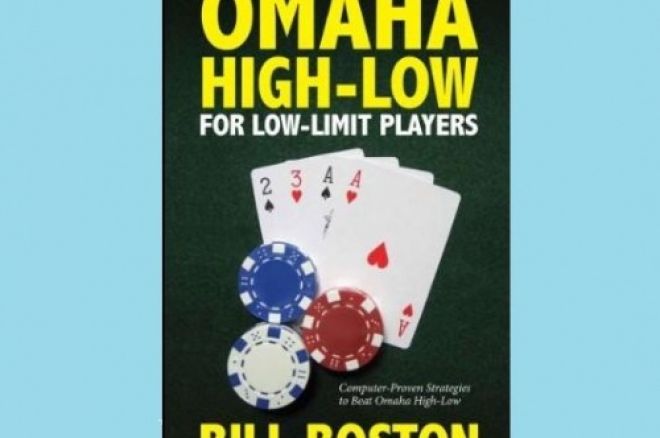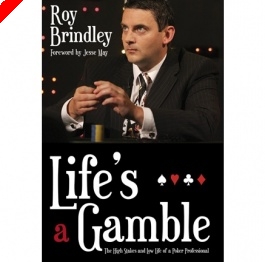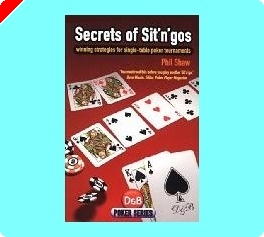Poker Book Review: Bill Boston's 'Omaha High-Low for Low-Limit Players'

"More than any other type of poker, omaha high-low is driven by hand value." Such is the position advanced by Bill Boston in Omaha High-Low for Low-Limit Players. Focusing on lower-stakes games ($2/4 to $5/10), the bulk of Boston's book is designed primarily to offer guidance regarding starting hand selection, an understanding of which Boston believes will necessarily set one apart from the great majority of those one generally encounters at these stakes.
At first glance, Boston's new book appears very similar to his previous Omaha High-Low, released in a new edition in 2006. Like that earlier title, the new book also features an introductory discussion of various Omaha high-low related concepts followed by a lengthy chart that ranks starting hands. However, while Omaha High-Low for Low-Limit Players covers much of the same ground as the previous book, it is a distinct work, with a slightly different emphasis and an entirely new starting hand chart.
As with Boston's earlier book, the centerpiece of Omaha High-Low for Low-Limit Players is the starting hand chart which takes up two-thirds of the book's length. As Boston explains, his goal was to provide an accurate ranking of the potential profitability of different starting hands in Omaha high-low. Using hand analysis software, Boston ran over 50 million hand simulations in order to produce his chart. All of the commentary that appears in the introductory chapters on "Selecting Profitable Hands to Play," "Avoiding Problem Hands," "Playing Marginal Hands," and the like is linked to the findings presented in Boston's chart. For example, recommendations to play A-2-x-x hands with two coordinated cards or to avoid hands with "trap connectors" like 6-7-8-9 are given additional support by the hand rankings that follow.
By altering some of his parameters for running the hand simulations, Boston has concocted a different starting hand chart than the one appearing in his earlier poker book. In Omaha High-Low, Boston programmed his "Computer Generated Player" (CGP) as a "tight" player who only saw flops with the best starting hands and also found himself at a table full of other players with similarly high starting hand requirements.
In his new book, Boston has his CGP see the flop with all 5,278 hands he considers, regardless of their potential to profit, then has programmed the CGP "to play solid Omaha high-low after the flop." The idea, Boston explains, is to illustrate more dramatically the effect of seeing flops in Omaha high-low with negative value hands. Here the CGP is an "average, aggressive player" pitted against a table composed of three other average players, two tight players, and three loose players. Boston's purpose here is to simulate a table full of opponents with "betting profiles similar to live action players normally found in low-limit games."
Many poker players are at least curious about starting hand charts, though have wildly varying opinions about their usefulness. The beginning hold'em player, for example, will at some point often seek out lists ranking the potential profitability of the 169 possible hand combinations one can be dealt in that game (after one discards hands of identical worth since suits have no relative value). While it probably isn't a good idea to become too dogmatic about starting hands, it is generally useful to understand, say, that A-Q suited is generally much more profitable a hand to play than K-9 offsuit, a fact that most hold'em charts reveal at a glance.
Being dealt four cards in Omaha means the possible hand combinations are much greater, making such charts especially unwieldy. Even after paring down the number by taking into account the fact that suits have no relative value, one is still left with a whopping 16,432 unique starting hand combinations in Omaha. Even if one could construct an accurate ranking of all of those hands, there remains a question of the practicality of such a list.
Boston therefore compromises somewhat by only considering 5,278 of the possible Omaha hands, including only hands that are non-suited (i.e., four cards of different suits), single-suited hands in which the highest ranking card is of the same suit as one other hole card, and double-suited hands in which the two highest ranking cards are matched with other pocket cards of the same suit. In other words, Boston does not consider hands containing four cards of the same suit, hands with three cards of the same suit, some double-suited hands, and some single-suited hands. According to such criteria, then, a hand like A?4?3?2? is listed, but A?4?3?2? is not. Boston's assumption appears to be that since these two hands play similarly there is no need to rank them separately.
Problems arise, however, whenever Boston makes reference to the probability of being dealt a specific hand or type of hand (as he does frequently), since he is only speaking with reference to less than a third of the possible hands one can be dealt. For instance, to underscore the need for being judicious with one's starting hands, Boston points out that "approximately 80 percent of the 5,278 hands shown in the charts have a negative value." One assumes the percentage of starting hands with negative value from the 16,432 unique hands one can actually be dealt is similar, but Boston's book doesn't say.
Other arguments about methodology could be pursued, but I'll leave those aside in favor of concluding with a couple of comments about the book's overall usefulness. Aside from chapters providing very cursory overviews of flop, turn, and river play, the introductory chapters are almost entirely devoted to the topic of starting hand selection. Much of that advice will be familiar to those who have read other Omaha high-low texts, including Boston's own earlier book (e.g., aces are good, middle cards are bad, look for hands with scoop potential, etc.). Boston's repeats here his admonition against preflop raising from his earlier book, a strategy he especially discourages in lower-stakes games. Also, a number of fairly basic issues of concern in Omaha high-low (e.g., the importance of position, getting quartered) are either mentioned in passing or neglected entirely.
Indeed, the main thrust of Boston's approach is simply to concentrate on the likelihood of making hands, pursuing those with potential and folding the rest. That said, given the nature of how the lower stakes games are often played, to practice the sort of restraint Boston recommends would likely give one the edge he suggests. "If you are an action player and like to play a lot of hands," Omaha high-low is not the game for you, says Boston, as "it is of utmost necessity that you develop iron-clad discipline and exercise good poker judgment" to succeed.
Finally, while the nearly 200-page starting hand chart is certainly interesting to leaf through, and appears to be a generally reliable reference for looking up the profitability of particular hands about which players have questions, it is hardly the ultimate "answers-to-all-your-questions" list some players who pick up Boston's book might hope to find. Of course, as we all know, such a list doesn't really exist, anyway.
Though not a comprehensive introduction to omaha high-low strategy, Boston's Omaha High-Low for Low-Limit Players does ultimately support its thesis that one cannot win without understanding both the need to be selective with one's starting hands and what are the best hands to select.
Get in on the action with a Full Tilt Poker Marketing Code at PokerNews.com - The Number 1 Source for Poker Information.








